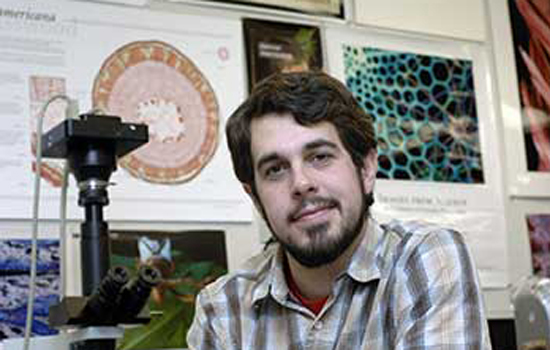Photo student finds pleasure in little things
A. Sue Weisler | photographer
Michael Hakans, fourth-year biomedical photographic communications major from the College of Imaging Arts and Sciences, loves merging imaging techniques with technical know-how.
Michael Hakans photographs the tiniest of things. Whether it’s a termite or the inside of the human eye or individual cells, the fourth-year biomedical photographic communications major uses specialized photographic equipment and microscopes to capture images needed in the science and medical fields. “It’s a look inside the small world of our everyday lives,” says Hakans.
Last summer, Hakans worked with some of the world’s top researchers and scientists at the Marine Biological Laboratory in Woods Hole, Mass. “Scientists who are the best in their fields conduct research there. The list of famous people who have walked through the doors is incredible. While I was there, Dr. Craig Mello, the 2006 Nobel Prize winner for his work on ribonucleic acid interference, shared his research,” says Hakans.
Hakans did a summer co-op at the Marine Biological Laboratory working for Carl Zeiss MicroImaging Inc., an international company that designs and produces light and laser microscope systems. Zeiss MicroImaging loans equipment to the lab to support scientific research. Research is conducted year-round, but in the summer the lab gets an influx of scientists and students. Hakans was in charge of assembling, installing and troubleshooting the systems. “We would go around and set up microscopes, make sure systems were running properly, seeing what kinds of experiments people were doing and what equipment they needed, and teaching them more of the imaging side of things. I liked the aspect of hands-on problem solving using my skills.”
During his past four years at RIT, the Babylon, N.Y., native has honed his skills in such areas as macro, ophthalmic and high magnification photography. The biomedical photographic communications program in the College of Imaging Arts and Sciences is the only one in the nation that grants a Bachelor of Science degree in this area of visual communications. “It was the program that brought me to RIT. It’s a photography program, but I will graduate with a bachelor’s degree in science because it’s a mix of imaging and technical know-how. When I came here, I realized I couldn’t be doing what I’m doing anywhere else.” Hakans relishes his educational experience, taking various courses outside of his major. “I’ve tried to dabble in as much as I could. I’ve taken kayaking classes. I’m currently taking craft classes and a class called Garbage Archaeology where we are using garbage as contemporary artifacts to learn about material culture and the habits of wasting and recycling.”
Carrying a 3.85 grade point average, Hakans has been an active member of the RIT Honors Program since his freshman year. In March, several honors students from CIAS will head overseas to the Czech Republic, Poland and Hungary. “I have never been to Europe, so I’m pretty excited.” Past trips with the CIAS Honors Program took students to Los Angeles, Chicago and Washington, D.C. “When we went to Washington, we visited the Secret Service and the FBI. We met an alumnus from my program that’s an FBI agent. He’s done forensics imaging at crime scenes and even facial reconstructive work. It was really interesting.”
Soon to be an alumnus himself, Hakans has his foot in the door at Zeiss MicroImaging and hopes to work there full-time after graduation. “My supervisor was very impressed with our knowledge. Zeiss has been using RIT as a breeding ground for employees for several years. Students who come out of the biomedical photographic communications program have the skills that Zeiss is looking for.”










